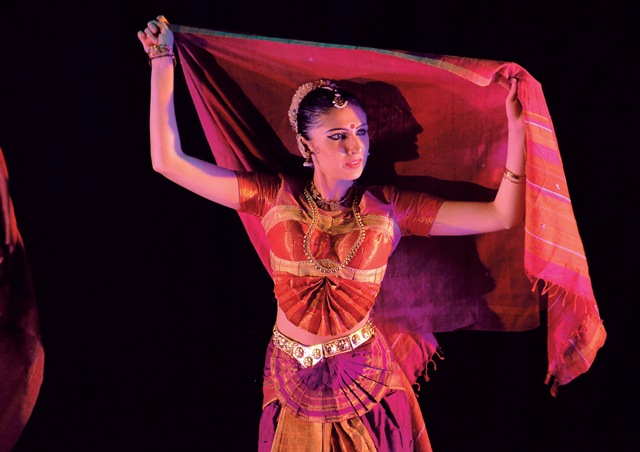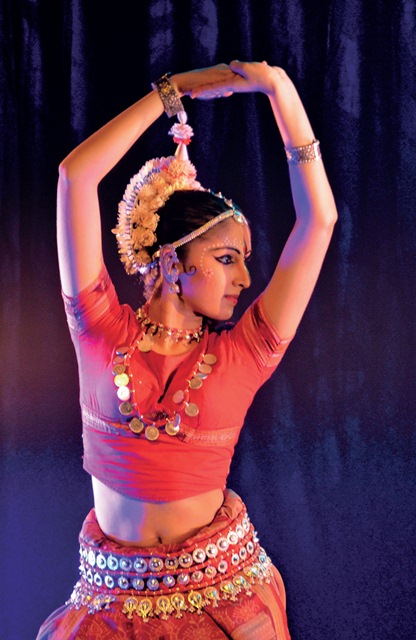Indian classical dance is a fairly new umbrella term that covers the mixture of styles of centuries-old Hindu musical theatre. Manveen Maan peers deeper into this ancient art that is still very much alive today.
India’s contemporary classical dances trace their origin far back in Indian history. Dance, like any other aspect of Indian culture and tradition, has developed over thousands of years, and is a very influential art form. Classical Indian dances today trace their roots to a book called the Natyasastra which forms the basis of all performing arts today.
Essentially, the history of dance in India can be divided into two periods: the first one from the 18th century BCE to the 10th century BCE, and the second from the 9th century BCE to the 2nd century BCE. During the first period, Sanskrit was the premier language for arts and hence had an influence on dance, which resulted in performances being similar throughout the country. The second period is characterised by regional diversifications and experimentations with newer ideas. Regional languages played an important role in diversifying the different dance traditions, as did the inclination to deviate from the principles of the Natyasastra. Indian dance almost died out during the British rule, but a tradition of over 5,000 years could not be wiped out that easily. By the early part of the 20th century, a revival of dances took place, and today there are many excellent artistes for each dance.
Bharatanatyam
Bharatanatyam is one of the most popular dance forms within the classical dance genre, and is practiced the world over by both male and female dancers. Originating in the southern state of Tamil Nadu, it is a reworked dance-form of the traditional “sadir” or temple dances from the 3rd and 4th centuries.
Known for its grace, purity, tenderness, and sculpture-like poses, Bharatanatyam is based on adavu (steps) and hasthamudra (hand gestures). There are a daunting 64 basic steps, and the dance itself is communicated through bhavabhinaya (facial expression), as well as the hand gestures. As with all classical Indian dances, performance starts with prayers to one or more Hindu gods. Bharatnatyam is considered to be a fire-dance — the mystic manifestation of the metaphysical element of fire in the human body. It is one of the five major styles that include Odissi (element of water), Kuchipudi (element of earth), Mohiniattam (element of air) and Kathakali (element of sky or ether). The movements of an authentic Bharatanatyam dancer are said to resemble the movements of a dancing flame.
Bharatnatyam proper is a solo dance, with two aspects: lasya, the graceful feminine lines and movements, and tandava the masculine aspect. In most solo performances, Bharathanatyam involves many split characters that are depicted by the dancer. However, in more modern times, group performances involving dramatic routines that require many characters depicted by various dancers have become common. In addition, these dance performances include numerous transitions and formations that are creatively choreographed to enhance the movements along with the music. Much like pro-athletes, classical dancers endure demanding performances that can last up to two hours.
Besides the beauty and ferocity of the dances themselves, the costumes of any Indian classical dance are simply spectacular. Bharatanatyam dancers wear intricate saris, heavy makeup, and beautiful headpieces. Ornaments of shining stones adorn their neck, ears, and hands, with jasmine garlands often seen in their hair, along with anklets with small bells – denoting the ability to teach or pass on the knowledge of the art.
Odissi
Hailing from the eastern state of Orissa, the Odissi dance form is a breathtaking show of strength, grace, and fluidity. Also known as Orissi, it is one of the oldest dance forms in India, and is particularly distinguished from other classical Indian dance forms by the importance it places upon the tribhangi, or the independent movements of head, chest, and pelvis. Odissi is characterised by various bhangas (stances), which involve the stamping of the foot and striking various postures as seen in Indian sculptures. Traditional Odissi repertoire consists of a mangalacharana (an invocation piece), followed by a Battu Nrutya (or Furious Dance) that is performed in the honour of Lord Shiva, the cosmic Lord of Dance. The Pallavi, a pure dance item in which a raga or tale is elaborated through eye movements, body postures and intricate footwork, follows. Literally meaning “blossoming”, the pallavi sees the development of the sequence of movements in the entire act.
An expressional dance that is an enactment of a song or poetry, called an Abhinaya, is then performed, conveying a story via mudras (hand gestures), bhavas (facial expression), and eye and body movements. The dance is fluid, very graceful, and sensual. A dance drama is next, usually with Hindu mythologies chosen as themes, but experimenting with the theme and form in recent years has led to unique creations.
The concluding item of a recital is a Moksha, or “spiritual liberation.” This dance represents a spiritual culmination for the dancer who soars into the realm of pure aesthetic delight.The dance develops into a crescendo, thrilling both the eye and the ear. With the cosmic sound of the “Om,” the dance dissolves into nothingness — just like Moksha or the deliverance of the soul from the human body.
Kathak

This ancient dance form can trace its origins to the nomadic poets of ancient northern India, known as Kathakars or storytellers. Its form today contains traces of temple and ritual dances, along with certain features of Persian dance and central Asian dance, that were imported by the royal courts of the Mughal era.
The Persian influence in the 16th century made an impact on the dance form. The demi-plié stance of most other Indian dance forms gave way to straight legs taken from the Persian dancers, breathing new vitality into the footwork. It was also during this period that the signature chakkars (spins) of Kathak were introduced, possibly influenced by the whirling dervishes.
As the dance developed, it gathered many additions to the narrative dance themes, resulting in a broader catchment of material, and a less stylized (and slightly informal) presentation style. Often incorporating improvisation and suggestions from various audiences, the fusion of cultures helped developed Kathak into a substantially different dance form. Its roots still remain though, in the hand-formations during storytelling, and some of the body postures that are still commonly found in various sequences. Interestingly enough, there are many striking similarities between Kathak and Flamenco, a southern Spanish dance style that received much influence from the local gypsies; most notably in the lack of much deviation from the vertical axis, percussive footwork, and dependence on (sometimes complex) rhythmic cycles.
Unlike other classical dancers, the Kathak dancer ditches the sari and uses a lengha-choli combination, consisting of a tight-fitting blouse and a loose anklelength skirt, to allow greater freedom of movement during dance. Both can be highly ornately embroidered or decorated. The lehenga is sometimes adapted to a special dance variety, so that during spins, the layered skirt flares out dramatically. Not to be outdone by their more classically traditional counterparts, ankle bells are worn to emphasize the flamboyant and elaborate rhythmic footwork of the Kathak dance itself.
Ancient Traditions in a Modern World

A renewed interest in the different dance forms over the past 50 years has contributed to the development of current dance styles. The uncovering of past glories has resurrected the artistic direction of Indian classic dance, with many styles today reflecting both ancient and contemporary traditions. New themes are infused within the techniques of old dance forms, which are sometimes performed outside the traditional milieu, yet still hold on to the authenticity of the original pieces. It is believed that the duty of the dancer is to create an atmosphere of peace through the art form, and the deep spiritual dedication that accompanies any performer of the classical dance style is testament to the outstanding skills, athleticism, and grace these dancers possess.
Read more:
"ExpatGo welcomes and encourages comments, input, and divergent opinions. However, we kindly request that you use suitable language in your comments, and refrain from any sort of personal attack, hate speech, or disparaging rhetoric. Comments not in line with this are subject to removal from the site. "






















